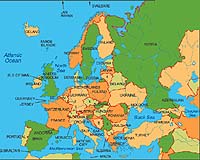| . |  |
. |
Melbourne (UPI) Apr 16, 2010 The Icelandic volcano closing airports across Europe could erupt for months, a geologist says. The volcano under the Eyjafjallajokull glacier erupted continuously for about six months two centuries ago, University of Melbourne earth sciences Associate Professor David Phillips told The Age. That eruption, in 1823, caused a fatal glacial lake outburst flood. The 5,466-foot-high, ice-capped volcano hadn't erupted again until March 20, scientists say. That eruption was relatively minor. But a new vent under the central crater opened late Tuesday and began spewing ash, the Nordic Volcanological Center in Reykjavik, Iceland, which monitors volcanic activity in the region, reported. This latest eruption sent a vast, high-altitude plume of ash across northern and central Europe, forcing the authorities to close airspace and ground airplanes to forestall potentially dangerous damage to jet engines. The volcano is generating so much ash because it's surrounded by ice and water, Phillips told the newspaper. "When you have hot lava interacting with that, it leads to more explosive eruptions," he said. "Basically these sort of explosive eruptions generate a lot of steam and a lot of volcanic gases, a lot of very fine fragments, rocks and solidified lava. Airlines are very, very careful about flying around volcanic ash because they can severely damage an aircraft." Once the glacial ice around the volcano melts, the amount of ash emitted into the air will likely drop, Phillips said. The ash cloud would probably dissipate within a few days once the eruption ceases, he told the newspaper. An expedition team returning from Eyjafjallajokull found the eruption still going strong, with massive billows of ash thrust into the air, Oli Aranson, a meteorologist at Iceland's national meteorological office, told The Wall Street Journal. He said the wind would continue to flow toward the British Isles until the middle of next week, although the ash could travel in a different direction if winds change.
Share This Article With Planet Earth
Related Links Bringing Order To A World Of Disasters When the Earth Quakes A world of storm and tempest
 Volcano cloud chaos grows over Europe
Volcano cloud chaos grows over EuropeLondon (AFP) April 16, 2010 A huge cloud of volcanic ash from Iceland cast a growing shadow over Europe on Friday, grounding thousands more flights in the continent's biggest air travel shutdown since World War II. As the giant no-fly zone stretched further, Europe's air traffic control centre predicted 17,000 flights would be cancelled Friday. Experts warned the fallout from the Eyjafjallajokull volcano in southea ... read more |
|
| The content herein, unless otherwise known to be public domain, are Copyright 1995-2010 - SpaceDaily. AFP and UPI Wire Stories are copyright Agence France-Presse and United Press International. ESA Portal Reports are copyright European Space Agency. All NASA sourced material is public domain. Additional copyrights may apply in whole or part to other bona fide parties. Advertising does not imply endorsement,agreement or approval of any opinions, statements or information provided by SpaceDaily on any Web page published or hosted by SpaceDaily. Privacy Statement |